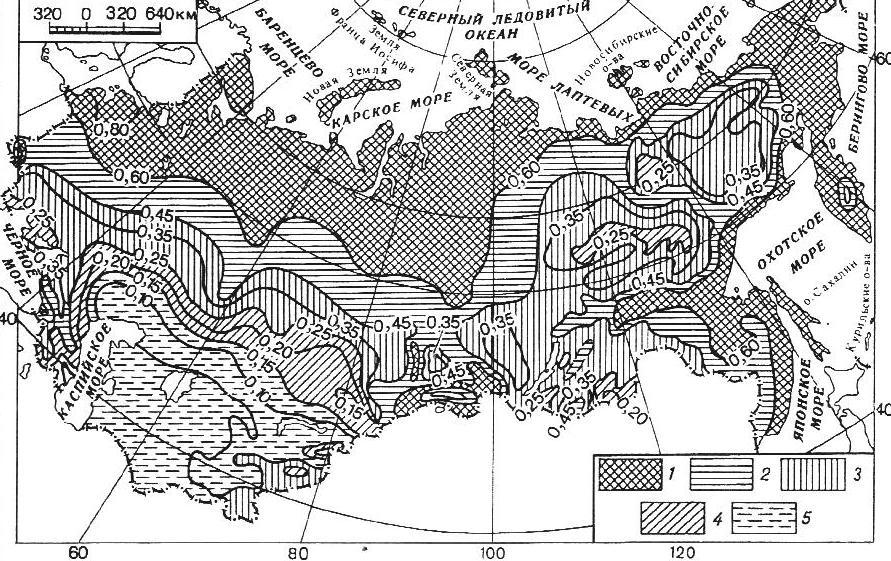Morozov
A.N.
Lecture 11. Where do we need irrigation.
| Result of oppositional
creative actions is chaos. |
| HUBBARD |

But…,
let us come back to water regime control of soil at irrigation and see, where
we should irrigate, and where we should not do that.
First of all, let us
find out conditions where irrigation is rational. This is a question solution
of which depends on not only from climate, but it is directly connected with economics
(i.e. with your wallet!).
If you cultivate cereal crops in the zone of unstable
moistening, where, for example, one severe drying year of five (when even to get
sprouting - is problem) is, one year is too wet (when yield of all crops wet through),
and only three years provide with conventional yield, then the question about
if we should irrigate is solved by economic evaluation. It is enough to compare
income of the yield in severe drying year, (and possibly also of other "conventional"
three years) with expenditures for irrigation management, and then everything
will be clear, if "the game is worth the candle"! We could and should
think hard also on alternative ways of farming that were described as early as
100 years ago by I.E. Ovsinsky whereby either dry years are not so terrible or
sowings do not wet through in the wet years.
If the climate in the site
where you live is such that nine of ten years (if not - all the ten!) do not provide
your sowings with moisture of natural precipitation, then, the question is solved
of itself, especially if there is no possibility to buy food anywhere there, or
because of shortage of money.
Zones of plants provision with moisture at
CIS territory were shown below at Picture 11.1. This picture illustrates how great
deficit of water is at any given sites.

Picture
11.1. Zones of plants provision with moisture at CIS territory. (1- over-moist
-more than 0,6; 2 - moist 0,45 …0,6 ; 3 - moderate 0,25 … 0,45; 4 -
semi-dried 0,10…0,25; 5 - dried less than 0,10 9the picture borrowed from
D.I.Shashko book "Agri-climatic zoning of USSR", (now "CIS")
Figures at the map, specifying level of sufficiency
of water availability of the marked zones means relationship of the annual precipitation
value to the potential evaporation per annum. Value of this relationship less
than 0,45 already indicates on insufficiency of natural moistening, at least in
some dry years. The map gives us certain information for speculation - if you
should think about irrigation in the location where you live.
And now,
we came down close to the question: if it is necessary to irrigate, then how to
do that better to avoid consequences which may be very money-loosed for your cly
and harmful for your soils.
No problems at first view! We are only to deliver
the amount of water that needed for crop cultivation within the time periods specified
for the crops. It is clear, isn't it? And there is another very "small"
problem there - how can we irrigate in a smooth flowing manner? And a field is
not flowerpot after all, the delivered water should be distributed in somehow
a smooth flowing manner over all its area.
And very seldom indeed we have
water which does not contain salts; even rainwater has mineralization 0,001 g/l
and more! River-water contains 0,2…0,4 g/l, and if drainage waters of your
neighbors upstream of your field is spilled to the river, then it can be even
1,5…3,0 g/l!
So, we are to think about if the delivered water is evaporated,
then where do disappear the salts which the water contains? Do you think that
it is sophisticated problem? But in fact, alkali soils occur even in Siberia though
there is not desert climate there at all!
It
is curiously enough, but many civilizations developed fast-paced in arid zones
with application of irrigation ended up in a bad way because they could not take
control over soils salinization. That is why, please, make a point, when your
take decision on irrigation procedure you should also think on discharge of drainage
water with contained salts in it and take into account water losses at the way
of delivering to the fields and at the fields themselves. We recommend you keep
in mind to think how you will catch and where you will spill these mineralized
losses… Submerge yourself, neighbor or to swamp, lake … back to the
river, to Aral Sea or another one?
WHERE???
May
be where these salts were before orderless irrigation, which was named with inoffensive
name as "melioration" by daring people?
And they were under soil
layer for millions years and appeared at surface only whereat were zones of ground
water outcrop. We shall discus about that farther in Lecture 15.

